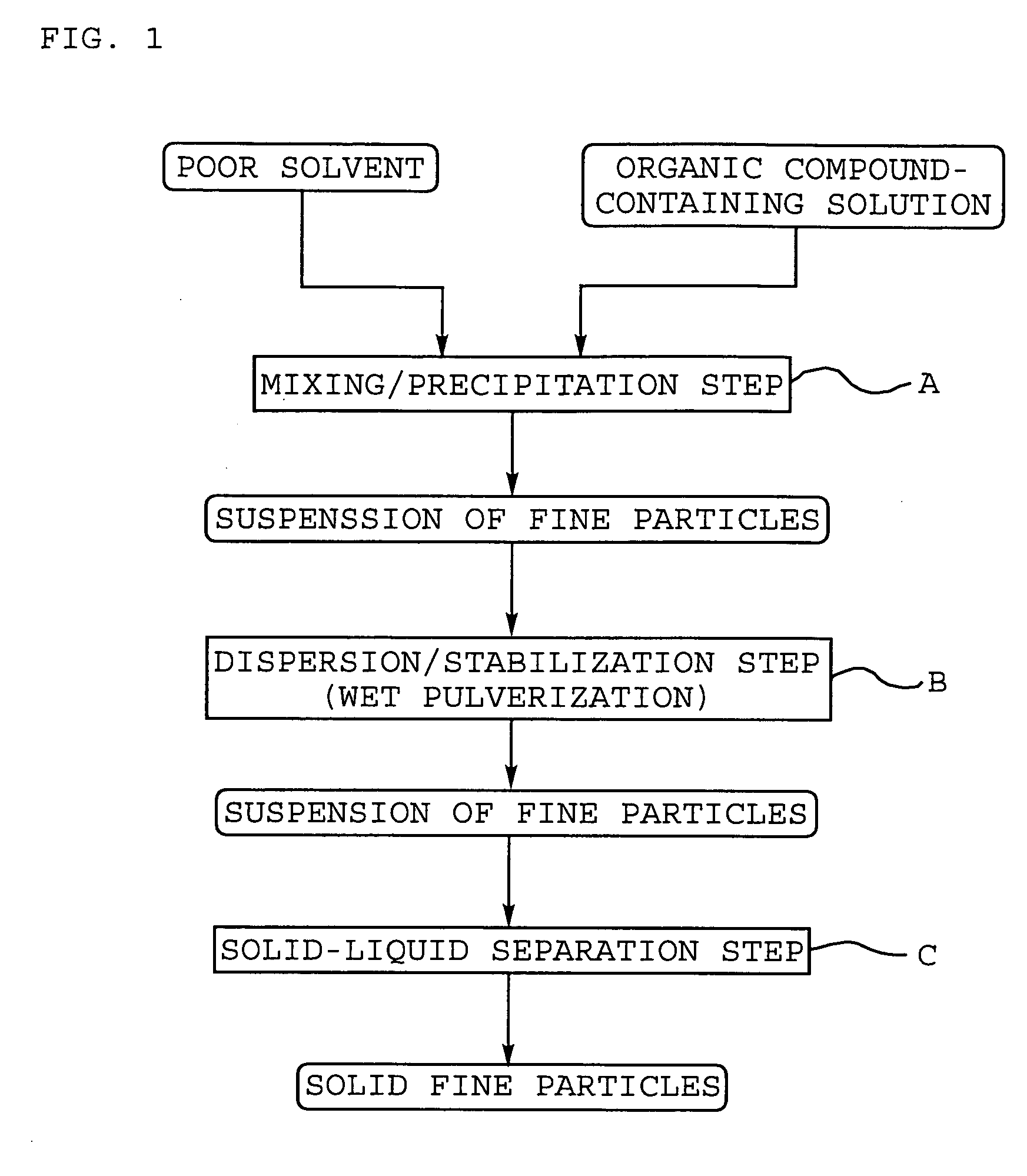Process for producing fine particles of organic compound
a technology of organic compound and fine particles, which is applied in the direction of separation processes, non-metal conductors, conductors, etc., can solve the problems of hardly water-soluble drugs, low elution rate of water-soluble drugs, and insufficient elution, etc., to achieve rapid and uniform dispersion and easy production
- Summary
- Abstract
- Description
- Claims
- Application Information
AI Technical Summary
Benefits of technology
Problems solved by technology
Method used
Image
Examples
examples 1 to 5
[0057] In the mixing / precipitation step (A), using a coaxial mixer with the structure as shown in FIG. 2(a), the poor solvent and the organic compound-containing solution were continuously mixed with each other to produce a suspension containing fine particles of the organic compound. The coaxial mixer had such a structure including a main flow path (1) constituted from a stainless steel cylindrical tube having an inner diameter of 7 mm, an introduction flow path (2) disposed within the main flow path (1) which was constituted from a stainless steel cylindrical tube having an outer diameter of 1.6 mm and an inner diameter of 0.8 mm, a large-diameter mixing chamber (3), and an ultrasonic homogenizer (“US-150T” (tradename) manufactured by Nippon Seiki Seisakusho Co., Ltd.; frequency: 20 kHz; output power: 150 W) equipped with an ultrasonic oscillator (4a) (ultrasonic horn having a diameter of 20 mm) which was inserted into the mixing chamber (3) so as to locate 5 mm just above an outl...
example 6
[0063] Indomethacin (solubility in water: not more than 1 mg / mL) as a hardly water-soluble organic compound was dissolved in ethanol (purity: 99.5%) as a good solvent therefor to prepare a drug-containing solution having a drug concentration of 10 mg / mL. As a poor solvent, there was used desalted water in which 0.625 mg / mL of sodium laurylsulfate was dissolved. Using the same coaxial mixer with a double tube structure as used in Examples 1 to 5, the poor solvent was supplied through the main flow path (1) at a flow rate of 76 mL / min, and the drug-containing solution was supplied through the introduction flow path (2) at a flow rate of 2 mL / min, and an ultrasonic wave was irradiated to the region where the two fluids were contacted with each other, at a frequency of 20 kHz and an output power of 150W and at room temperature (about 25° C.), thereby producing a suspension of fine particles. The thus produced suspension of fine particles was immediately measured using a dynamic light-sc...
PUM
| Property | Measurement | Unit |
|---|---|---|
| Temperature | aaaaa | aaaaa |
| Solubility (mass) | aaaaa | aaaaa |
| Solubility (mass) | aaaaa | aaaaa |
Abstract
Description
Claims
Application Information
 Login to View More
Login to View More - R&D
- Intellectual Property
- Life Sciences
- Materials
- Tech Scout
- Unparalleled Data Quality
- Higher Quality Content
- 60% Fewer Hallucinations
Browse by: Latest US Patents, China's latest patents, Technical Efficacy Thesaurus, Application Domain, Technology Topic, Popular Technical Reports.
© 2025 PatSnap. All rights reserved.Legal|Privacy policy|Modern Slavery Act Transparency Statement|Sitemap|About US| Contact US: help@patsnap.com



